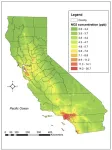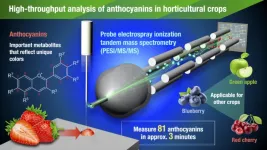(Press-News.org) Cross-sectional study of 1,123 participants confirms α-synuclein seed amplification assay (αSyn-SAA) technique is highly accurate at identifying people with Parkinson’s disease.
The technique detects at-risk individuals and those with early, non-motor symptoms of Parkinson’s disease prior to diagnosis, suggesting that a positive result on αSyn-SAA may be an early indicator of disease onset.
Differences in the frequency of a positive αSyn-SAA result were detected based on age and sex, and if people carried the LRRK2 and GBA gene variants – which can lead to Parkinson’s disease – or had sporadic cases of the disease.
Findings suggest a key role for αSyn-SAA as a biomarker to aid early detection of Parkinson’s disease and to classify people into subgroups that may have different underlying causes for their symptoms and could have different responses to treatment. Historically, no biochemical test could provide a conclusive diagnosis during life, and the disease has been defined based on clinical symptoms and characteristic brain pathology.
A technique that identifies the build-up of abnormal protein deposits linked to Parkinson’s disease could aid in early detection and play a key role in the disease's clinical diagnosis and characterisation, according to research published in The Lancet Neurology journal.
Findings from the study confirm the technique – known as α-synuclein seed amplification assay (αSyn-SAA) – can accurately detect people with the neurodegenerative disease and suggest it can identify at-risk individuals and those with early, non-motor symptoms prior to diagnosis. The presence of misfolded α-synuclein protein aggregates in the brain is the pathological hallmark of Parkinson’s disease.
Co-lead author Professor Andrew Siderowf, of the University of Pennsylvania Perelman School of Medicine (USA) and Parkinson Progression Marker Initiative (PPMI) investigator, says: “Recognizing heterogeneity in underlying pathology among patients with Parkinson’s disease has been a major challenge. Identifying an effective biomarker for Parkinson’s disease pathology could have profound implications for the way we treat the condition, potentially making it possible to diagnose people earlier, identify the best treatments for different subsets of patients, and speed up clinical trials.” [1]
“Our findings suggest that the αSyn-SAA technique is highly accurate at detecting the biomarker for Parkinson’s disease regardless of the clinical features, making it possible to accurately diagnose the disease in patients at early stages. Moreover, our results indicate that misfolded α-synuclein is detectable before dopaminergic damage in the brain is about to be observed by imaging, suggesting ubiquitous spread of these misfolded proteins before substantial neuronal damage has occurred,” adds study co-lead author Luis Concha, director of research and development at Amprion (USA). [1]
The new study is the largest analysis of the diagnostic performance of αSyn-SAA for Parkinson’s disease. While previous research has shown αSyn-SAA can distinguish clearly between individuals with Parkinson’s disease and people without the condition, no large-scale studies including such a broad range of carefully described participants have been conducted until now.
The authors assessed the usefulness of αSyn-SAA for identifying underlying heterogeneity in people with Parkinson’s disease, and its ability to detect early signs of the condition, using data from the Parkinson’s Progression Markers Initiative (PPMI) cohort. [2] Among the 1,123 participants in the analysis were individuals with a diagnosis of Parkinson’s disease and at-risk people with gene variants (GBA and LRRK2) linked to the condition. So-called prodromal participants were also included. These people had non-motor symptoms – sleep disturbance or loss of smell – that can be early signs of Parkinson’s disease, but they had not been diagnosed with the disease and had none of the typical motor symptoms, such as tremors or muscle stiffness, which come later in the disease’s development. The reason to include prodromal participants was to determine whether αSyn-SAA might predict the onset of Parkinson’s as well as help diagnose people with established symptoms.
Samples of cerebrospinal fluid that surrounds the brain and spinal cord – from each participant were analysed using αSyn-SAA. This breakthrough technique amplifies very small amounts of misfolded aggregates of α-synuclein in samples from people with Parkinson’s disease to the point that they can be detected using standard laboratory techniques.
Findings of the analyses confirm that αSyn-SAA identifies people with Parkinson’s disease with high accuracy, with positive results in 88% of all participants with a diagnosis (combining sporadic and genetic cases).
In sporadic cases – those with no known genetic cause – 93% of individuals had a positive αSyn-SAA result. However, results varied for people with genetic forms of Parkinson’s disease, with 96% of those with the GBA variant having a positive αSyn-SAA, compared with 68% of those with LRRK2.
Most prodromal participants had positive αSyn-SAA results, indicating they had α-synuclein aggregates despite not yet being diagnosed with Parkinson’s disease. Among those recruited based on their loss of smell, 89% (16/18 participants) had positive αSyn-SAA results. Similarly, in people with REM sleep behaviour disorder, a sleep disturbance that is known to be a precursor to Parkinson’s disease, positive αSyn-SAA results were present in 85% (28/33) of cases. No other clinical features were associated with a positive αSyn-SAA result.
In participants who carried LRRK2 or GBA variants but had no Parkinson’s disease diagnosis or prodromal symptoms – known as non-manifesting carriers (NMCs) – 9% (14/159) and 7% (11/151), respectively, had positive αSyn-SAA results.
Importantly, most prodromal participants and NMCs with positive αSyn-SAA had brain scans that did not show a decline in the expected number of dopamine-producing nerve cells – a biomarker signature that is present even before diagnosis. This result suggests build-up of α-synuclein aggregates may be a very early indicator of disease onset.
The clinical feature that most strongly predicted a positive αSyn-SAA result was loss of smell – one of the most common symptoms in prodromal people and those with a Parkinson’s disease diagnosis. Among all participants with Parkinson’s disease who had loss of smell, 97% had positive αSyn-SAA compared to 63% of those whose sense of smell was unchanged.
"While loss of smell appears to be a strong predictor of Parkinson’s disease, it's important to note that this study identified individuals with positive αSyn-SAA results, but who had not yet lost their sense of smell, indicating that α-synuclein pathology may be present even before there is a measurable loss of sense of smell. Our study looked at patients a fixed point in time only, and further research is needed to find out how patients’ sense of smell may change over time, and how this relates to the build-up of a-synuclein aggregates in the brain,” says study author Dr Tanya Simuni of Northwestern University (USA). [1]
Some differences in αSyn-SAA results were also seen based on age and sex, particularly among people with a mutation in LRRK2. While 55% of female Parkinson’s disease participants with an LRRK2 variant had a positive αSyn-SAA result, the figure for males was 79%. People with an LRRK2 variant and negative αSyn-SAA results also tended to be older (69 years vs. 62 years) than those with positive αSyn-SAA results. Among males and females with sporadic or GBA-associated Parkinson’s disease, the results did not differ.
Autopsy data for 15 participants, all with a Parkinson’s disease diagnosis in life, showed 14 had typical pathology and were αSyn-SAA positive. The one αSyn-SAA negative case was an individual whose sense of smell was unchanged in life and who also carried the LRRK2 variant.
The authors acknowledge some limitations to their study. Greater numbers of samples would improve analyses by helping to overcome issues posed by factors including skewed data and low sample numbers for some participant groups. The analyses presented are all cross-sectional, but the availability of PPMI samples collected over time would enable future studies to assess changes over specific time periods. Longer-term studies are also needed to further investigate differences in αSyn-SAA results between people with different genetic forms of Parkinson’s disease.
Writing in a linked Comment, Professors Daniela Berg and Christine Klein, of University Hospital Schleswig-Holstein, Germany, who were not involved in the study, highlighted the significance of the finding that αSyn-SAA could spot early signs of disease: “Siderowf and colleagues showed that people with prodromal Parkinson’s disease and non-manifesting mutation carriers had abnormal α-synuclein aggregation before any other detectable clinical or biomarker changes, a finding that lays the foundation for a biological diagnosis of Parkinson’s disease…” To harness the full potential of αSyn-SAA, they say blood tests will need to be developed: “Although the blood-based method needs to be further elaborated for scalability, αSyn-SAA is a game-changer in Parkinson’s disease diagnostics, research, and treatment trials.”
NOTES TO EDITORS
The study was funded by The Michael J. Fox Foundation for Parkinson’s Research and a consortium of more than 40 private and philanthropic partners. A full list of researchers and institutions is available in the Article.
[1] Quote direct from author and cannot be found in the text of the Article.
[2] PPMI is an international, observational study with the goal of identifying clinical and biological markers of disease heterogeneity and progression in Parkinson’s disease: https://www.ppmi-info.org/.
The labels have been added to this press release as part of a project run by the Academy of Medical Sciences seeking to improve the communication of evidence. For more information, please see: http://www.sciencemediacentre.org/wp-content/uploads/2018/01/AMS-press-release-labelling-system-GUIDANCE.pdf if you have any questions or feedback, please contact The Lancet press office pressoffice@lancet.com
END
The Lancet Neurology: Identifying ‘hallmark’ Parkinson’s disease protein build-up could aid early detection and pave way for improved diagnosis and treatment
2023-04-13
ELSE PRESS RELEASES FROM THIS DATE:
Free trade deal is a major threat to UK public health, warn experts
2023-04-13
The UK’s decision to join one of the world’s largest free trade agreements, known as the Comprehensive and Progressive Agreement on Trans-Pacific Partnership (CPTPP), poses a major threat to UK public health, warn experts in The BMJ today.
In acceding to the CPTPP, the government hopes to boost trade, improve economic growth, and strengthen the UK’s strategic position as a global rule setter.
But Courtney McNamara and colleagues argue that free trade deals have serious and wide ranging implications for public health and ...
Female healthworkers need better radiation protection to minimise breast cancer risk
2023-04-13
Women working in healthcare who are regularly exposed to radiation from x-rays and other imaging procedures need better ionising radiation protection to help minimise their risk of developing breast cancer, argue doctors in The BMJ today.
Ionising radiation is a known human carcinogen and breast tissue is highly radiation sensitive. As such, there are concerns that regular exposure to ionising radiation during image guided procedures may be linked to a higher risk of breast cancer in female healthcare workers.
Personal protective equipment (PPE) such as lead gowns are used to shield the body from harmful radiation during these ...
Higher dose corticosteroids associated with a 60% increased risk of death in hypoxic COVID-19 patients requiring only non-invasive oxygen therapy (The Lancet / RECOVERY trial)
2023-04-13
*Note: this is a joint press release from the European Congress of Clinical Microbiology & Infectious Diseases (ECCMID) and The Lancet. Please credit both the congress and the journal in your stories*
A new study to be presented at this year’s European Congress of Clinical Microbiology & Infectious Diseases (ECCMID 2023, Copenhagen 15-18 April), and published in The Lancet, shows that, compared with standard care that included low dose corticosteroid use, treating hypoxic COVID-19 patients needing ...
Assisted reproduction kids grow up just fine – but it may be better to tell them early about biological origins, twenty-year study suggests
2023-04-13
Paper available at: https://drive.google.com/drive/folders/1y9GfgYkRdUtwyq6nBhySePTUHZYP6iAj?usp=share_link
Landmark study finds no difference in psychological wellbeing or quality of family relationships between children born by assisted reproduction (egg or sperm donation or surrogacy) and those born naturally at age 20.
However, findings suggest that telling children about their biological origins early – before they start school – can be advantageous for family relationships and healthy adjustment.
The study, by University of Cambridge researchers, is the first to examine the long-term ...
The hidden culprit behind nitrogen dioxide emissions
2023-04-13
Nitrogen dioxide is one of the criteria air pollutants that plays an important role as a precursor gas of fine particulate matter and ozone. NO2 emissions are known to be primarily generated by industrial facilities or vehicle exhausts. Recently, a research team from POSTECH analyzed satellite remote sensing data from the European Space Agency (ESA) and released results showing that food processing facilities and high-rise apartments that are 10 stories or higher are significant sources of NO2 emissions. Their findings have drawn attention from NASA.
A ...
Notable birth cohort effects on the incidence trend of renal replacement therapy in Japan
2023-04-13
Niigata, Japan - A new Japanese study reveals significant birth cohort effects on the incidence trend of ESKD requiring RRT.
“Different birth cohorts may have different levels of exposure to a particular risk factor, which may produce a change in disease incidence for individuals born at a particular time, i.e. a cohort effect,” said Dr. Wakasugi, the corresponding author of the study. “Age-Period-Cohort (APC) analysis, a statistical method to distinguish between age, period, and ...
Time out: We all need a three-day weekend
2023-04-13
As a four-day work week is trialled in countries across the globe, health researchers at the University of South Australia say they’re ‘all in’ when it comes to a long weekend, especially as new empirical research shows that the extra time off is good for our health.
Assessing changes in daily movements before, during and after holidays, researchers found that people displayed more active, healthy behaviours when they were on holiday, even when they only had a three-day break.
Across the 13-month study period, people generally took an average two to three holidays, each being around 12 days. The most common holiday type was ‘outdoor ...
Using a new technique, PESI/MS/MS, to analyze the nutritional compounds in crops
2023-04-13
Anthocyanins are compounds related to the color of plants. They also have beneficial effects on human health and are used as a supplement. Various species of anthocyanins, divided by their molecular shape, are present in plants. Therefore, simple, and rapid, analytical techniques that can distinguish among these species in crops are necessary for breeding and quality assessment. A team of Nagoya University researchers in Japan has used a technique called probe electrospray ionization tandem mass spectrometry (PESI/MS/MS) to analyze anthocyanins in crops. ...
HKU biologists determine the evolutionary age of individual cell types providing critical insights for animal development
2023-04-13
A research team led by Dr Chaogu ZHENG from the School of Biological Sciences at The University of Hong Kong (HKU) has recently made a significant discovery about the evolutionary age of different type of cells in a small animal called Caenorhabditis elegans (C. elegans). By using single-cell transcriptomic data and refined phylostratigraphy, the team determines the transcriptomic age of individual cells, which means they are able to estimate the evolutionary origin of different cells based on the age of the genes expressed in the ...
Coral-eating fish poo may act as ‘probiotics’ for reefs
2023-04-13
Until recently, fish that eat coral — corallivores — were thought to weaken reef structures, while fish that consume algae and detritus — grazers — were thought to keep reefs healthy. But scientists have discovered that feces from grazers leave large lesions on coral, possibly because they contain coral pathogens. By contrast, feces from corallivores may provide a source of beneficial microbes that help coral thrive.
“Corallivorous fish are generally regarded as harmful because they bite the corals,” said Dr Carsten Grupstra of Rice University, ...




